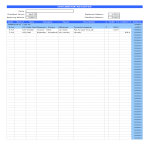Checkbook register templates
What is a Checkbook Register Spreadsheet and how to use a Checkbook Register Spreadsheet Printable?
A Checkbook Register Spreadsheet is a tool used to track and manage personal or business finances by recording all transactions made from a checking account. This includes deposits, withdrawals, and transfers, helping to keep an accurate balance and monitor spending.
Using a Checkbook Register Spreadsheet Printable:
Date: Ensure to enter the date of each transaction. This helps keep track of when each deposit, withdrawal, or transfer was made.
Transaction Details: Include detailed information about each transaction. This should consist of the check number (if applicable), the type of transaction (deposit, withdrawal, transfer), and a brief description or memo about the transaction.
Payee/Payer Information: Record the name of the payee or payer for each transaction. This adds clarity and helps in tracking who money is being paid to or received from.
Amount: Clearly state the amount of money for each transaction. Use separate columns for debits (withdrawals) and credits (deposits) to maintain clarity.
Balance: Continuously update the running balance after each transaction. This ensures that you always know the current balance of the checking account.
Categories: Categorize each transaction if necessary. This can help in budgeting and understanding where your money is going, such as groceries, utilities, rent, etc.
Reconciliation: Periodically reconcile your checkbook register with your bank statement. This helps to identify any discrepancies and ensures that your records match the bank’s records.
Signature: For additional security, you may want to sign off on each entry or page after reconciliation. This provides a record that you have verified the accuracy of the entries.
Save yourself time and effort by downloading this free Checkbook Register Spreadsheet printable. It is provided as a free downloadable template for your convenience and can be customized to fit your specific needs.
-
Free Printable Check Register
How do you create a simple checkbook register with Microsoft Excel? Check out this easy to use free printable check register in MS Excel format
View template -
Checkbook Register Template
How to make a Checkbook Register in Excel? An easy way to create your spreadsheet is by downloading this example Checkbook Register Excel spreadsheet template n
View template
Latest topics
- Excel Templates
Where do I find templates for Excel? How do I create a template in Excel? Check these editable and printable Excel Templates and download them directly! - GDPR Compliance Templates
What do you need to become GDPR compliant? Are you looking for useful GDPR document templates to make you compliant? All these compliance documents will be available to download instantly... - Google Docs Templates
How to create documents in Google Docs? We provide Google Docs compatible template and these are the reasons why it's useful to work with Google Docs... - IT Security Standards Kit
What are IT Security Standards? Check out our collection of this newly updated IT Security Kit Standard templates, including policies, controls, processes, checklists, procedures and other documents. - Letter Format
How to format a letter? Here is a brief overview of common letter formats and templates in USA and UK and get inspirited immediately!

